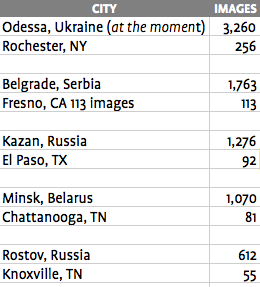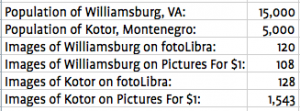The Russians Are Coming!
March 12th, 2014by Gwyn Headley
Managing Director
Tags: $1, 25 million, Belgrade, Chattanooga, dollar, El Paso, fotoLibra, Fresno, images, Kazan, Knoxville, Kotor, Minsk, Montenegro, Odessa, picture library, pictures for a dollar, Rochester, Rostov, Russians, stock agency, Williamsburg
25 million images for a dollar each!
Yet another ‘stock agency’ has bulk-emailed the world (why should spam trouble them?) to tell us we can buy images from them for a dollar each.
Of course you can’t actually buy a picture from them for a dollar, despite what they promise. You have to start by paying a minimum of ten dollars, at which point they’ll throw in nine extra pictures (which you may or may not want) for free.
The pound, the euro, the yen and the rouble don’t concern them; they only want your dollars.
The business model is to blind buyers with price and quantity, and gloss over content and quality. Pile ’em high, sell ’em cheap. It’s a well-used model.
But talking of content and quality, the balance of image subjects seems wrong for a website which appears to be US-based and aimed primarily at American buyers. Compare these eastern and western cities, all with populations around the million mark. Here are the number of images Pictures For A Dollar (not its real name, natch) has of each location:
As for my headline, I have no idea if this site has anything to do with our Russian friends. But there does seem to be a definite Eastern flavour to the content. As the table above demonstrates, there are ten times as many images of former Soviet bloc cities than of American cities. Which is very useful if you are publishing to the Eastern European market.
Check out these two tourist destinations:
Where did this Pictures For A Dollar site acquire its images, do you think? From all the figures quoted, it certainly looks more Eastern than Western.
I assume they own all these images, so they don’t have to pay the photographers. Therefore all the business costs are pumped into marketing the static stock. There is no indication that there will be new additions to the 25 million images they hold — the website baldly states “Pictures For A Dollar is not accepting contributors at this time.”
Why does this upset me? Because this has nothing to do with photography. Photographers are not welcome on this site.
This is a commodity sale, which will directly affect the livelihood of yet more photographers. I very much doubt that the photographers who supplied the majority of images which ended up on Pictures For A Dollar are going to see a cent for their work. And I don’t think that’s fair.
What worries me is how can a picture library (British usage) or stock agency (American usage) like fotoLibra compete?
I hope it will be by providing well-keyworded, precise, high-quality, up-to-date AND historical images that people actually want and need, not a dubious flytip of cheaply acquired bulk collections that might pass at a pinch.
Or do you have other ideas?




From a brief glance at a recent BJ I saw that a certain ‘Western’ stock agency is making images available for nothing provided the purpose is ‘non-commercial’.
Did I get that right ?
So perhaps your Russian (?) outfit is only being competitive ?
Isn’t that what Capitalism is supposed to be all about ? Peanuts and Monkeys come to mind of course but if you’re content with Monkeys….?
It makes one despair at the future of our once-proud picture industry – and indeed of our very profession. Doubtless it’ll all sort itself out in due course but the openings, opportunities and income for young photographers are likely to be far more limited than they were for us.
Yes, Getty are allowing people to use images for free in blog posts providing there’s a link to ?their site? ?the image?
The thinking is that any publicity is good publicity. I tend to agree.
Why do you assume they own the photos and didn’t just pick them up from Facebook and Instagram? : )
If that was the case why would they select 10 times as many Eastern European subjects as American subjects?
And even on the Wild West Frontier of image sharing, copyright essentially still remains with the photographer and … it’s no country for old men.
Hello Gwyn,
I thought you might be interested in the Whois & IP data for what I think is the agency (“club”) in question:
Whois:
dollarphotoclub.com
31.25.82.5
Thibaud ELZIERE
Fotolia LLC
41 East 11th Street,11th floor
New York
New York
10003
United States
Phone: +1.7185771321
domain@fotolia.com
NS1.P24.DYNECT.NET
NS2.P24.DYNECT.NET
NS3.P24.DYNECT.NET
NS4.P24.DYNECT.NET
Google Page Rank : Unknown
Alexa Traffic Rank : 50,720
Created: 2012-03-08T21:59:12Z
Updated: 2014-02-05T21:11:21Z
Expires: 2015-03-08T21:59:12Z
Source: whois.gandi.net
Completed at 12/03/2014 11:52:17
Processing time: 5.9
4 seconds
And the IP:
31.25.82.5
31.25.80.0 – 31.25.87.255
Fotolia SARL
France
Fotolia NOC
Fotolia
66, avenue des Champs Elysees
75008 Paris
noc-ripe@fotolia.net
abuse@fotolia.net
FR-FOTOLIA-20110303
Updated: 01-Aug-2011
Source: whois.ripe.net
Completed at 12/03/2014 11:53:09
Processing time: 1.03 seconds
No mention of Russia in the above though.
By the way, seeking “Glamorgan” produces a few results! All very pretty but hardly inventive – maybe that’s what the users of picture libraries want???
Keep up the good work.
Thanks Barry, very educative. They must have sourced them from a faraway country about which we know little.
Gywn, forget about the ‘Russians’ coming. And forget too that a huge number of the give-away sites are actually German-owned. Google is coming.
You may have noticed that with the integration of Google Drive and the Google+ Photos service (The Archive Formerly Known As Picasa), Google can quietly invade Poland, the rest of the former Eastern bloc and indeed the world and no-one will notice. Until, that is, they announce that you can choose to offer a license for any photo in your already uploaded and tagged collection (for the minor inconvenience of signing a model release and a liability waiver) to everyone else in the world and earn up to 20c in the dollar on every sale! Free money, or maybe better still free AdWords vouchers.
If anyone can give a list of good reasons why this will NOT happen, I’d love to know. My guess is Google are ironing out kinks, and waiting for the tipping point where income from image licenses sold that way would exceed income from wannabe stock sellers currently fighting each other for the top spot in search results and on affiliate sites.
It’s not 1991 any more, and it’s Google’s sandpit. All your pictures are belong to us. Game over.
And I guess that when they make the offer to photographers, inertia will be taken as acceptance. We banned that for mail order in the UK in the 1960s.
Supply hugely exceeds demand. Simple. Forget about making money out of images – those days are gone forever.Sad but true.
Making a good living out of stock images may be past. But we still sell enough to want to carry on. Maybe we’re just pugnacious.
Philip is almost right, but not entirely. Supply does not UNIFORMLY exceed demand.
The ONLY way you Gwyn (and all the other libraries still hoping to sell more ‘traditional’ licenses), can continue to subsidise your existing model (ie offering huge numbers of rarely-requested images) is to do two things:
1 – insist on image exclusivity, thus ring-fencing supply of each image, and accept that many (most?) images will go from rarely selling to never selling (and some photographers will stop contributing or pull content). This is no guarantee of long-term survival, as the eventual demise of Apple will attest (someone else will always come along and do it better and cheaper than you, and more INclusively). But you can buy some time while you innovate. Plus the ‘walled garden’ approach only really works for a longer time if you’re the incumbent or first-to-market.
2 – Datamine! Or, ‘wants lists on steroids’. You can’t compete with the image bucket shops, so instead why not corral an elite cadre of committed photographers (not snappers) and together set about providing what buyers cannot (despite trying) find elsewhere for less?
You (and other libraries like you) have access to quantities of existing data no individual photographer can hope to replicate, and frankly it’s your trump card. Time to play it (but only show your hand to your exclusive suppliers – don’t be British about it and give the patent away!)
However noble (or pugnacious) your intentions, you are not running a country bus service (or even a mobile library). Unless aggregators evolve into active partners with their contributors generating sought-after images (instead of becoming bloated portals to mediocrity), the potential profits will be spread too thinly across all the players to be sustainable.
So, do you want to ‘carry on’, or do you still have fire in your belly? Don’t wait until they’re on the beaches, take the fight to them!
Definitely has snow on its boots!
Хорошее здоровье!
You worry too much. this is such an obvious scam that whoever falls for it derserves to.
It would appear not. Barry Hughes did some research (posted above) and a remarkably similar offering is being made by fotoLia, which apart from half ripping off our company name seems to be a perfectly legit business.
What bothers me about this? It’s what bothers me about the industry. My comment is not directed to anyone in particular, not photographers, other sellers (on behalf of photographers) and buyers. Nobody and everybody. There are two kinds of law in this photography business. Copyright and Contract. Most people know what copyright is. Many don’t know how it works, with specific regard to registration, at least here in the USA, (I don’t know enough about the rules in Europe, or these days, other countries) and what the ramifications are one way or the other. There is a blur of talk. Copyright speaks to the image itself. It is generally the contract around the license that determines whether or not Copyright/Registration means anything. I’d like the industry to really understand the mechanics of Copyright protection and the contracts that ultimately govern one’s ability to use that protection to their benefit.
The previous comments talk about Instagram, their Terms and Conditions, that is, their contract with you, give them rights and, if you put it up there, guess what’s going to happen? Instagram is a useful business too. Just be selective and aware and, maybe, watermark your images. Getty? Does the contract you signed give you the ability to object or not participate in any program they think up? I bet not, but it’s a contract. Google +, contract. Violation of any usage? License written. Contract. We don’t hear very much about contract and yet, everything a photographer does is controlled by a contract.
Max speaks of a stock model that he feels is different. there are a few of these out there, but they don’t dominate the industry. It still comes down to the contractual agreement between the photographers, the representing entity and, of course, the license written.
I think we need to learn and teach each other about…
Contracts.
Best regards,
Anna Fey